unit10 I'd like some noodles.sectionB(2a-2c)教学通案
- 格式:doc
- 大小:43.50 KB
- 文档页数:3
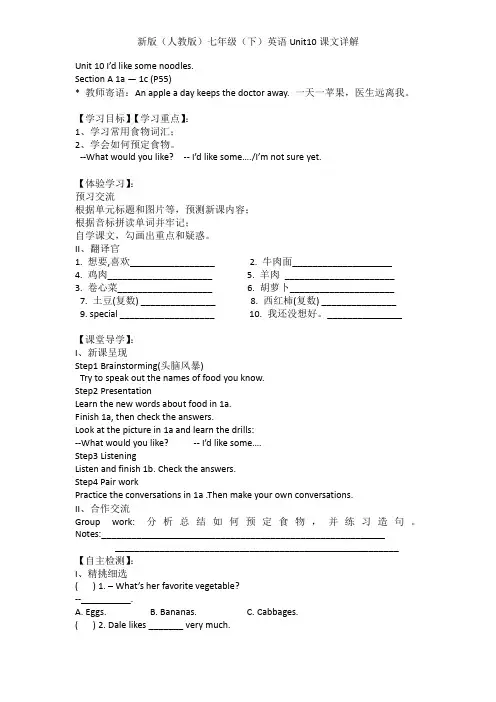
Unit 10 I’d like some noodles.Section A 1a — 1c (P55)* 教师寄语:An apple a day keeps the doctor away. 一天一苹果,医生远离我。
【学习目标】【学习重点】:1、学习常用食物词汇;2、学会如何预定食物。
--What would you like? -- I’d like some…./I’m not sure yet.【体验学习】:预习交流根据单元标题和图片等,预测新课内容;根据音标拼读单词并牢记;自学课文,勾画出重点和疑惑。
II、翻译官1. 想要,喜欢_________________2. 牛肉面____________________4. 鸡肉_____________________5. 羊肉______________________3. 卷心菜___________________ 6. 胡萝卜_____________________7. 土豆(复数) _______________ 8. 西红柿(复数) _______________9. special ___________________ 10. 我还没想好。
_______________【课堂导学】:I、新课呈现Step1 Brainstorming(头脑风暴)Try to speak out the names of food you know.Step2 PresentationLearn the new words about food in 1a.Finish 1a, then check the answers.Look at the picture in 1a and learn the drills:--What would you like? -- I’d like some….Step3 ListeningListen and finish 1b. Check the answers.Step4 Pair workPractice the conversations in 1a .Then make your own conversations.II、合作交流Group work: 分析总结如何预定食物,并练习造句。
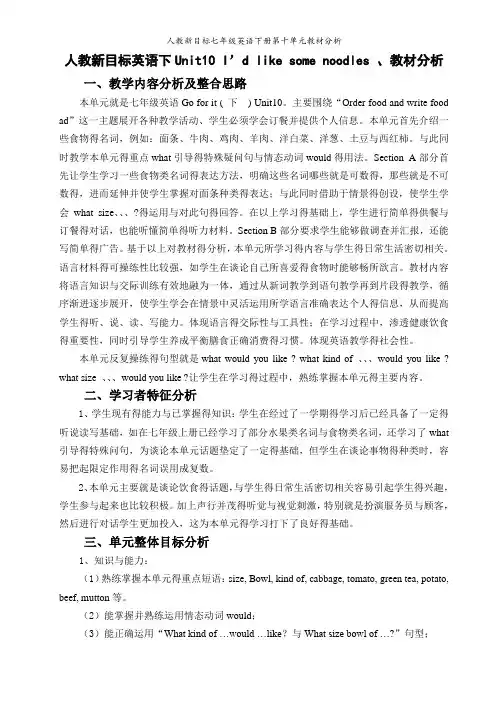
人教新目标英语下Unit10 I’d like some noodles 、教材分析一、教学内容分析及整合思路本单元就是七年级英语Go for it ( 下) Unit10。
主要围绕“Order food and write food ad”这一主题展开各种教学活动、学生必须学会订餐并提供个人信息。
本单元首先介绍一些食物得名词,例如:面条、牛肉、鸡肉、羊肉、洋白菜、洋葱、土豆与西红柿。
与此同时教学本单元得重点what引导得特殊疑问句与情态动词would得用法。
Section A部分首先让学生学习一些食物类名词得表达方法,明确这些名词哪些就是可数得,那些就是不可数得,进而延伸并使学生掌握对面条种类得表达;与此同时借助于情景得创设,使学生学会what size、、、?得运用与对此句得回答。
在以上学习得基础上,学生进行简单得供餐与订餐得对话,也能听懂简单得听力材料。
Section B部分要求学生能够做调查并汇报,还能写简单得广告。
基于以上对教材得分析,本单元所学习得内容与学生得日常生活密切相关。
语言材料得可操练性比较强,如学生在谈论自己所喜爱得食物时能够畅所欲言。
教材内容将语言知识与交际训练有效地融为一体,通过从新词教学到语句教学再到片段得教学,循序渐进逐步展开,使学生学会在情景中灵活运用所学语言准确表达个人得信息,从而提高学生得听、说、读、写能力。
体现语言得交际性与工具性;在学习过程中,渗透健康饮食得重要性,同时引导学生养成平衡膳食正确消费得习惯。
体现英语教学得社会性。
本单元反复操练得句型就是what would you like ? what kind of 、、、would you like ? what size 、、、would you like ?让学生在学习得过程中,熟练掌握本单元得主要内容。
二、学习者特征分析1、学生现有得能力与已掌握得知识:学生在经过了一学期得学习后已经具备了一定得听说读写基础,如在七年级上册已经学习了部分水果类名词与食物类名词,还学习了what 引导得特殊问句,为谈论本单元话题垫定了一定得基础,但学生在谈论事物得种类时,容易把起限定作用得名词误用成复数。
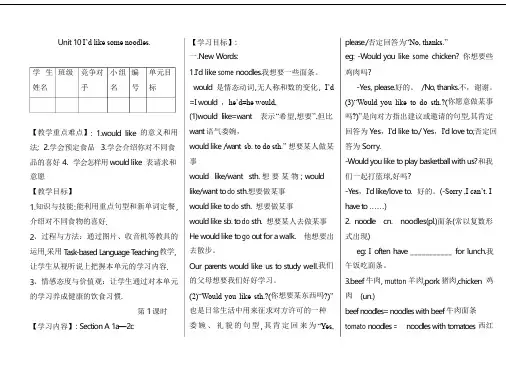
Unit10I’d like some noodles.【学习目标】:一.New Words:please./否定回答为“No,thanks.”eg:-Would you like some chicken?你想要些学生班级竞争对小组编单元目 1.I'd like some noodles.我想要一些面条。
鸡肉吗?姓名手名号标would是情态动词,无人称和数的变化,I’d-Y es,please.好的。
/No,thanks.不,谢谢。
【教学重点难点】: 1.would like的意义和用法; 2.学会预定食品 3.学会介绍你对不同食品的喜好4.学会怎样用would like表请求和意愿【教学目标】1.知识与技能:能利用重点句型和新单词定餐,介绍对不同食物的喜好.2、过程与方法:通过图片、收音机等教具的运用,采用T ask-based Language T eaching教学,让学生从视听说上把握本单元的学习内容.3、情感态度与价值观:让学生通过对本单元的学习养成健康的饮食习惯.第1课时【学习内容】:Section A1a—2c =I would,he’d=he would,(1)would like=want表示“希望,想要”,但比want语气委婉,would like/want sb.to do sth.”想要某人做某事would like/want sth.想要某物;wouldlike/want t o do sth.想要做某事would like t o do sth.想要做某事would like sb.t o do sth.想要某人去做某事He would like t o go o u t for a walk.他想要出去散步。
Our parents would like us t o study well.我们的父母想要我们好好学习。
(2)“Would you like sth.?(你想要某东西吗?)”也是日常生活中用来征求对方许可的一种委婉、礼貌的句型,其肯定回来为“Yes,(3)“Would you like to do sth.?(你愿意做某事吗?)”是向对方指出建议或邀请的句型,其肯定回答为Yes,I'd like to./Yes,I'd love to;否定回答为Sorry.-Would you like t o play basketball with us?和我们一起打篮球,好吗?-Y es,I'd like/love to.好的。
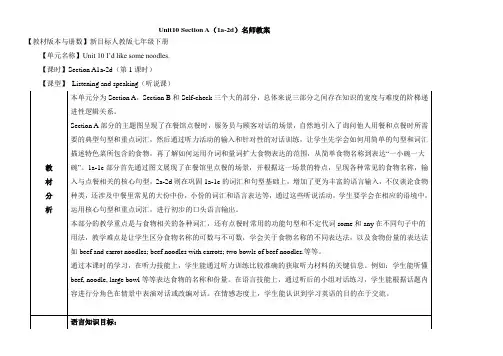
Unit10 Section A(1a-2d)名师教案【教材版本与册数】新目标人教版七年级下册【单元名称】Unit 10 I’d like some noodles.【课时】Section A1a-2d(第1课时)【课型】Listening and speaking(听说课)附:教学活动设计步骤过程措施(教师活动与学生活动)目的持续性评价1预备与激活先期知识Step 1Greeting andLeading in(2mins)Show a picture and let the students answer the questionsbelow:1)Can you see three bowls?2)What are in them?3) Do you like noodles?4)Can you find the differences among the three bowls ofnoodles?通过图片引入话题,并通过提问引入课时单词学习。
部分学生能说出“noodles”,少部分学生能说出“beef noodles”。
2获取新知识Step 2Pre-listening(3mins)1. Teach the new words of food used in noodles.2. Look at the numbered list of ingredients. Read andrepeat.3. Ask students to match each word with the foods in 1a.4. Present the countable and uncountable nouns.5.List many words, and let the students discuss in groupsand tell us what kinds of nouns these words are.Ss practice in pairs like this:A: What kind of noodles would you like?B: I’d like beef and tomato noodles, please.A: What size bowl of noodles would you like?为1b的听力作铺垫准备和搭支架,这样通过直观图片和单词匹配的方式,能让学生更容易记住这些食物名称,也为后面的听说活动扫清了一部分词汇障碍。
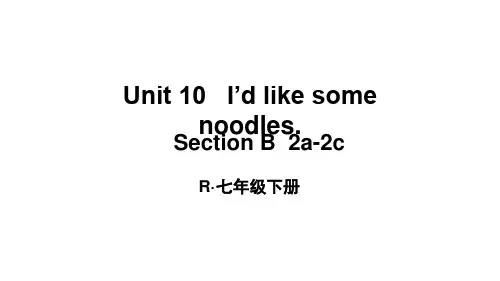


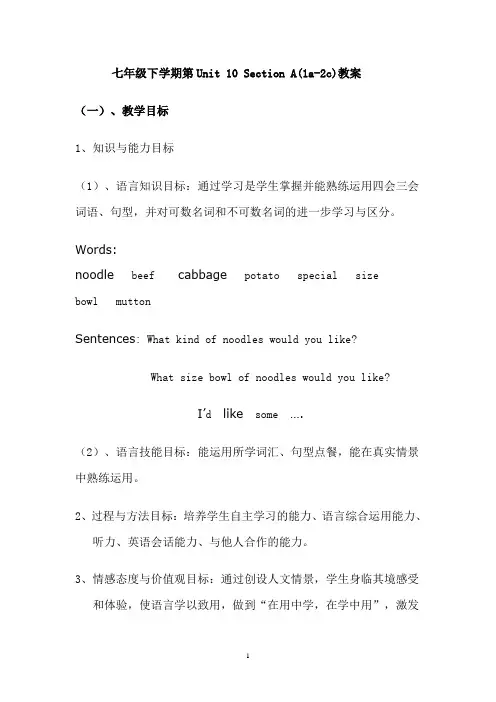
七年级下学期第Unit 10 Section A(1a-2c)教案(一)、教学目标1、知识与能力目标(1)、语言知识目标:通过学习是学生掌握并能熟练运用四会三会词语、句型,并对可数名词和不可数名词的进一步学习与区分。
Words:noodle beef cabbage potato special sizebowl muttonSentences: What kind of noodles would you like?What size bowl of noodles would you like?I’d like some ….(2)、语言技能目标:能运用所学词汇、句型点餐,能在真实情景中熟练运用。
2、过程与方法目标:培养学生自主学习的能力、语言综合运用能力、听力、英语会话能力、与他人合作的能力。
3、情感态度与价值观目标:通过创设人文情景,学生身临其境感受和体验,使语言学以致用,做到“在用中学,在学中用”,激发学生的学习积极性。
体会在活动中学习英语的乐趣。
培养学生乐于与他人合作的精神及养成科学的饮食习惯。
(二)、教学重点与难点重点:1、学习日常生活中有关食物的名称。
2、进一步学习与区分可数名词与不可数名词。
3、含有would like 的特殊疑问句及其回答。
难点: 1、would like 的用法。
2、模拟生活场景点菜、用餐等对话。
三、教学过程课前准备:一些食物、饮料、甜品的可粘帖小图片。
前5分钟2.Presentationfood on the big screen)Let Ss guess what food itis.3. Listening1 . Listen and complete t1.T: In the followingconversation, one man isordering some food.Now, let’s listen to thetape, find out the rightnoodles the personorders.____ Special 1____ Special 2____ Special 32. Play the recording forthe Ss to listen and checkthe answers.the conversation.Waitress:____________________?Boy: I’m not sure yet.顺理成章进入到下一环节,没有突兀感,在复习旧知(食品名称)的同时初步感知新知。
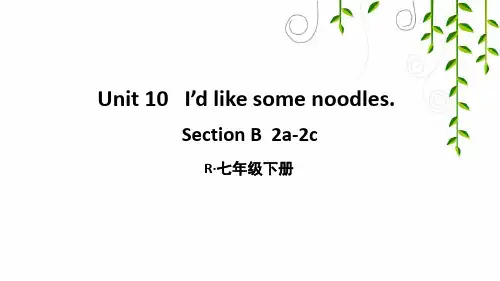
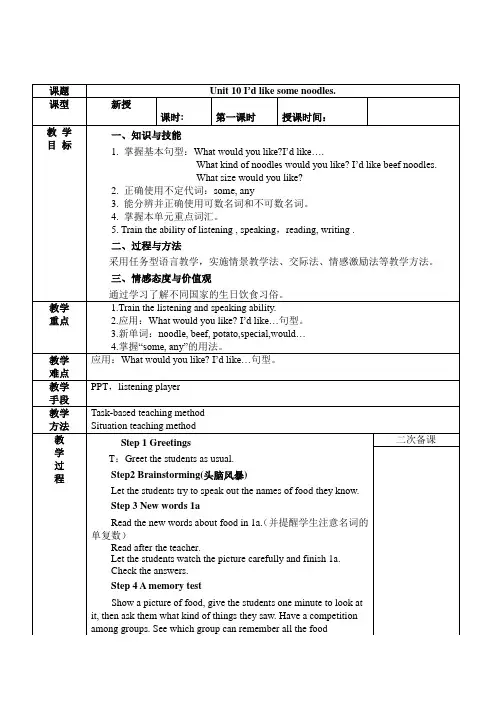
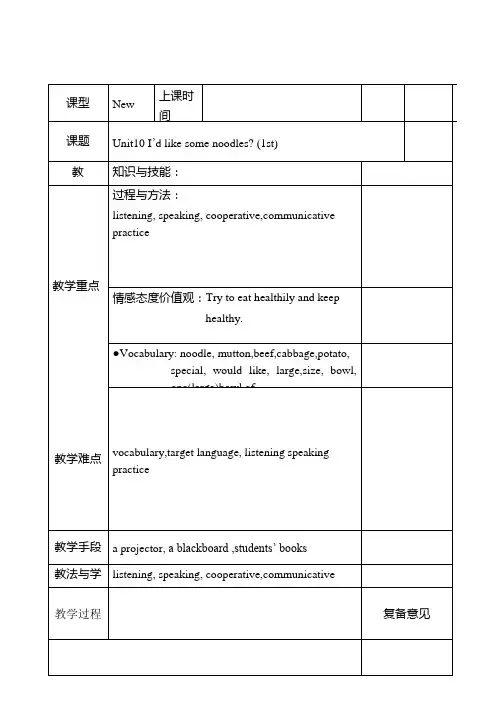
课型 New 上课时间课题 Unit10 I ’d like some noodles? (1st)教 学知识与技能:教学重点过程与方法:listening, speaking, cooperative,communicative practice情感态度价值观:Try to eat healthily and keep healthy.●Vocabulary: noodle, mutton,beef,cabbage,potato,special, would like, large,size, bowl, one(large)bowl of教学难点vocabulary,target language, listening speaking practice教学手段 a projector, a blackboard ,students’ books 教法与学法 listening, speaking, cooperative,communicativemethods 教学过程复备意见Step 1 Greetings & Lead-in● Greet students as usual.● S how students a picture on the screen. Encouragestudents to answer the questions.●“The noodles looks delicious.I am hungry, I want to eatsome.”(Write the sentence on the blackboard)● Introduce the words “would like”. “I would like to makesome noodles for you. First we must buy something.Let’s go to the supermarket.”●Help students to get familiar with the vegetables andmeat. Remind them of the plural forms.Step 2 Presentation●Show them the picture of vegetables and meat. Helpthem to discuss what kind of vegetable or meat theywould like by asking and answering.●“Now let’s make our noodles. I would like noodles withbeef and tomatoes.What kind of noodles would youlike?” Help students to discuss the 4 specials.●Ask them to work in pairs to talk about their specials.●“OK, let’s eat noodles. What size bowl of noodleswould you like?” Show them the words “small,medium, large” on the screen. Help them get familiarwith the target language.●Show them the complete conversation between thewaitress and customer. Encourage them to role play theconversation.●Encourage them to work in pairs or groups to maketheir own conversations.Step 31a Match● Have them read the words in the list. Then encouragethem to match the words with the foods.●Check answers.Step4 1b &1c Read, Listen & Check●Call attention to the conversations in 1a. Ask them toread it together. Remind them of the three kinds ofspecials in the picture. Ask them to makeconversations in two groups using the given pictures.●“ You’ll listen to the tape. Try to make clear whichspecial the boy orders.”● Play the tape for the first time. Students try to listen andfind out the answers.●Play the tape again. Students try to repeat and imitate it. Step5 2a Listen & Check● Call attention to the words in the chart. Have some poorstudents to read the words.●“You will listen to the tape. Try to check the names ofthe foods you hear.”● Play the tape for the first time, students listen and check.Then check answers.Step6 2b Listen & Complete●Read the uncompleted sentences to students. “You willlisten to the tape again. This time try to make clear what kind of noodles and what size bowl of noodles the boyand the girl would like.”●Play the tape again,students listen and fill.●Check answers.Step7 Language Points & Practice● Help students to go through the language points.● Ask them to do the exercise by themselves. Then check answers. Step7 Summary● Help students to go through the vocabulary and target language.●“Let’s learn to eat healthy food and keep healthy”小结提高In this period, we learned some kinds of vegetables and meat. We leaned some kinds of noodles.There are all kinds of foods in our daily life. We all need to eat healthy food and keep healthy.-22-a a12121212板书设计Unit10 I’d like some noodles. potatoes tomatoes carrotsMutton beef chicken--What kind of noodles would you like?--I'd like beef and potato noodles.--What size bowl of noodles would you like? --I'd like a large bowl of noodles.教学反思优点:缺点:改进措施:作业布置1.Copy new and memorize new words.2.Make several conversations.。
七年级下册教案与试卷 Unit 10 I’d like some noodles.
Section A (The First Period) 一、Teaching Goals 1. Can read and write the words below. noodle beef cabbage potato special would bowl size large 2.Sentence patterns --What kind of noodles would you like? --I’d like beef noodles --What size would you like? --I’d like a medium bowl. 3. Can understand the conversations about ordering the foods. 二、Teaching keys and importance 1. Grasp key words 2. Can order foods 三、Teaching Process: Step One: Leading--in T: What do you like for breakfast? S: I like milk and eggs for breakfast. T: Do you like noodles? S: Yes,I do. T: I like noodles, too. I want some noodles. = I would like some noodles. I’d Step two:learn new words Show a picture of Noodles House. There are many special in the Noodles House. And then learn different kinds of noodles according to the pictures 七年级下册教案与试卷 Special 1 beef tomatoes → beef and tomato noodles Special 2 chicken cabbage → chicken and cabbage noodles Special 3 mutton potatoes → mutton and potato noodles Special 4 egg tomatoes → egg and tomato noodles
Adversity makes a man wise, not rich. 逆境出人才。
- 1 -
年级 学科 主备人 使用时间
学生姓名 班级
课题 Unit10 I’d like some noodles. Section B (2a-2c) 课型 new 教师复备栏或
学生笔记栏
学习目标
1. main phrases: make a wish blow out in one go come true get popular bring good luck to the number of …. 2. main sentences: The number of candles is the person’s age. If he or she blows out all the candles in one go, the wish will come true. The long noodles are a symbol of long life.
学习重点
巩固本单元语法结构的理解和掌握新单词与词组。
学习难点
短文中的词汇和短语。
课前任务
一. 词汇大集结 (练一练 学一学)(A good beginning is half
done.)
全世界 蜡烛
糖果 一次性,一口气
……的数目 在英国
长寿面 如果 实现
给….带来好运 吹灭 切碎
许愿 长寿的象征
受欢迎,流行
二. 语言点解读
Birthday food(生日食品) 和birthday foods(各种各样的生日食品)
作为不可数名词,food意为“食物,物品”,故birthday food为“生日
食品”;在birthday foods这个表达法中,系可数名词,这是相当于汉语“各
种各样食品”的意思,表示食物、食品种类的多样。如:
Where’s your section of frozen foods?你们的冷冻食品区在哪里?
Birthday person寿星;过生日的人
Adversity makes a man wise, not rich. 逆境出人才。
- 2 -
此处birthday person是一个合成词。当代英语中,人们为了回避语言中
的性别歧视或性别化现象,越来越多地使用person这个中性词来合成相关词
汇,如:chairperson主持人; sportsperson运动员; salesperson售货员;
spokesperson发言人.
课堂学习过程
Step I lead in the new lesson
Step II Read
1. read the article silently and complete the chart on Page 59.
2. check the answer the questions.
Step III Read the article again and answer the questions on Page 59. ()
StepⅣ Language points
Language point1 (把书合上:吃一堑,长一智)
1. The answer would be different (在不同国家)
2. (…的数目) candles is the person’s age.
3. If he or she can eat all of the food (一次性)
Language point2
根据句意,从方框内选择合适的单词、短语,并用适当形式填空。
In make a wish cut up long life get
popular
Blow out bring good luck to the number of
a number of
1. 1999, he lived in Russia with his family.
2. It is to have red hair.
3. They never the noodles because the long noodles are a
symbol of long life.
4. I hope the lucky tree will you.
5. The long noodles are a symbol of .
6. Before you eat the birthday cake, you should .
7. If he all the candles in one go, the wish will come true.
8. students in our class is fifty.
Adversity makes a man wise, not rich. 逆境出人才。
- 3 -
9. students are playing on the playground.
语言点解析:
A number of与 the number of 看上去差不多,就是冠词不一样,但意
思却相差很远。a number of表示“许多….”,修饰可数名词的复数,
不能修饰不可数名词。在意思上相当于many,谓语动词用复数形式。
The number of表示“…的数目”,谓语动词常用单数形式。主语不是
of后面的名词。
StepⅤ Exercises in class
连词成句
1. it, getting,, popular, is, have, to, cake, birthday, your, on.
2. noodles, are, long, the, long, life, a, symbol, of.
3. they, good, luck, bring, to, birthday, person, the.
4. number, the, candles, the, is, person’s, of, age.
StepⅥ Homework (Actions speak louder than words.事实胜于雄辩。)
What do you do or eat on your birthday?
学
后
收
获
课
后
反
思